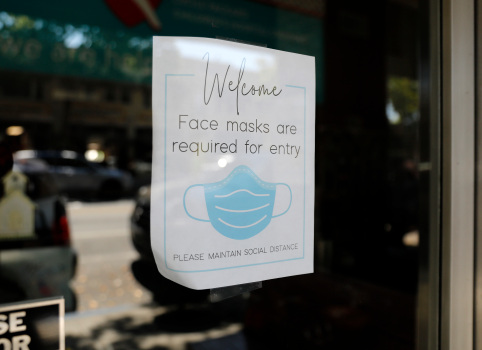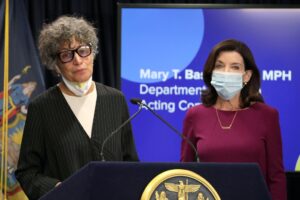California health officials Monday confirmed that the current statewide requirement that everyone wear face masks at indoor public places regardless of vaccination will be loosened as planned after Feb. 15.
Here’s how the California Department of Public Health says things will change:
Q Who will be allowed to go inside without a mask?
A Starting Feb. 16, people who are vaccinated won’t be required to wear a face mask in most indoor public settings. The mask requirement will remain for the vaccinated.
Q Will vaccinated people still have to wear face masks in some places?
A Yes, face masks still will be required for everyone regardless of vaccination status in higher risk settings. Those include public transit, health care facilities, emergency heating and cooling centers and congregate living settings including long-term care, homeless shelters and correctional facilities. It also applies to school classrooms and other buildings and child care centers.
Q Is anything changing now?
A The state health department allowed a rule added Jan. 7 requiring a negative COVID-19 test in addition to proof of full vaccination and a booster shot if eligible to enter long-term care facilities such as nursing homes to expire Monday as planned.
Q Is anything else changing Feb. 16?
A Yes, the state also is loosening the requirement for proof of vaccination or a negative COVID-19 test for large events. In December, the event size triggering the requirement was reduced from indoor events of more than 1,000 people to indoor events of more than 500 people. On Feb. 16, it once more will apply to the larger events of more than 1,000 people. The state is also had recommended vaccination proof or a negative COVID-19 test for outdoor events of more than 5,000 people, and that will return to outdoor events of more than 10,000 people on Feb. 16.
Q Why aren’t the rules changing for schools?
A California had maintained its indoor mask requirement for schools since last summer, and the U.S. Centers for Disease Control and Prevention recommends universal indoor masking by all students, staff, teachers, and visitors to K-12 schools, regardless of vaccination status. California health officials Monday said that they are “continuing to work with education, public health and community leaders to update masking requirements at schools to adapt to changing conditions and ensure the safety of kids, teachers, and staff.”
Q Are other states requiring face masks for everyone in schools?
A Many others do, but that is changing. This week, officials in Connecticut said they would lift their statewide school mask requirement Feb. 28. New Jersey officials said they will lift their statewide school mask requirement March 7. Delaware and Oregon said their school mask requirement will end March 31.
Q Will the new state mask rules apply everywhere?
A Not necessarily. While the statewide requirement will end, that doesn’t prevent local health officials from maintaining more strict rules as they see fit. Los Angeles County, for example, is not planning to drop its indoor mask requirement until case rates recede to the CDC’s “moderate” level and hospitalizations fall.
Similarly, several Bay Area counties have local indoor mask requirements regardless of vaccination. San Francisco officials said they are “evaluating our county masking requirements in light of the upcoming changes to state guidance and will announce any changes to local orders as soon as they are finalized.”
Alameda County health officials said they are “evaluating the role of our local face masking order in light of the expected state mask policy changes” and will provide an update before February 15.
Q What about workplaces?
A Those will continue to follow CalOSHA guidelines which include requiring and providing masks for unvaccinated workers to wear indoors and in vehicles around others.
Q Why are the rules changing?
A COVID-19 cases have been declining after a winter surge that peaked in January. But they are declining unevenly across states and counties. Every state currently remains at the CDC’s red “high” transmission level, indicating 100 or more cases per 100,000 people over the last seven days. In California, only Modoc and Sierra counties have reached the CDC’s yellow “moderate” transmission tier for 10-49 cases per 100,000 over the past week, while Alpine County is at the orange “substantial” level for 50-99 cases per 100,000 over the past week.
California’s statewide rate of 933 cases per 100,000 people over the past week is more than three times the 239 cases in New Jersey, and higher than the 579 in Florida.



















